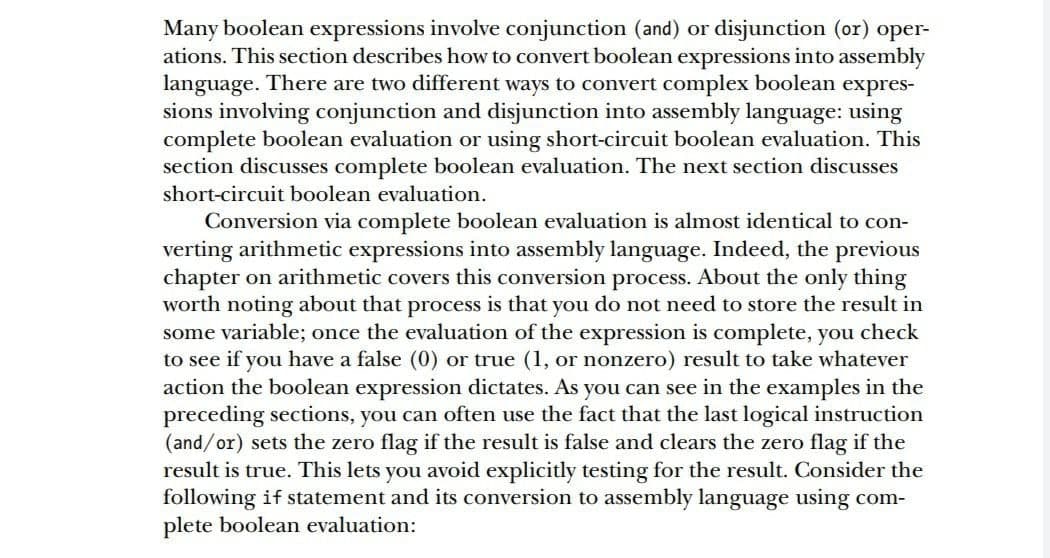Many boolean expressions involve conjunction (and) or disjunction (or) oper- ations. This section describes how to convert boolean expressions into assembly language. There are two different ways to convert complex boolean expres- sions involving conjunction and disjunction into assembly language: using complete boolean evaluation or using short-circuit boolean evaluation. This section discusses complete boolean evaluation. The next section discusses short-circuit boolean evaluation. Conversion via complete boolean evaluation is almost identical to con- verting arithmetic expressions into assembly language. Indeed, the previous chapter on arithmetic covers this conversion process. About the only thing worth noting about that process is that you do not need to store the result in some variable; once the evaluation of the expression is complete, you check to see if you have a false (0) or true (1, or nonzero) result to take whatever action the boolean expression dictates. As you can see in the examples in the preceding sections, you can often use the fact that the last logical instruction (and/or) sets the zero flag if the result is false and clears the zero flag if the result is true. This lets you avoid explicitly testing for the result. Consider the following if statement and its conversion to assembly language using com- plete boolean evaluation:
Many boolean expressions involve conjunction (and) or disjunction (or) oper- ations. This section describes how to convert boolean expressions into assembly language. There are two different ways to convert complex boolean expres- sions involving conjunction and disjunction into assembly language: using complete boolean evaluation or using short-circuit boolean evaluation. This section discusses complete boolean evaluation. The next section discusses short-circuit boolean evaluation. Conversion via complete boolean evaluation is almost identical to con- verting arithmetic expressions into assembly language. Indeed, the previous chapter on arithmetic covers this conversion process. About the only thing worth noting about that process is that you do not need to store the result in some variable; once the evaluation of the expression is complete, you check to see if you have a false (0) or true (1, or nonzero) result to take whatever action the boolean expression dictates. As you can see in the examples in the preceding sections, you can often use the fact that the last logical instruction (and/or) sets the zero flag if the result is false and clears the zero flag if the result is true. This lets you avoid explicitly testing for the result. Consider the following if statement and its conversion to assembly language using com- plete boolean evaluation:
Computer Networking: A Top-Down Approach (7th Edition)
7th Edition
ISBN:9780133594140
Author:James Kurose, Keith Ross
Publisher:James Kurose, Keith Ross
Chapter1: Computer Networks And The Internet
Section: Chapter Questions
Problem R1RQ: What is the difference between a host and an end system? List several different types of end...
Related questions
Question
if somebody can

Transcribed Image Text:Many boolean expressions involve conjunction (and) or disjunction (or) oper-
ations. This section describes how to convert boolean expressions into assembly
language. There are two different ways to convert complex boolean expres-
sions involving conjunction and disjunction into assembly language: using
complete boolean evaluation or using short-circuit boolean evaluation. This
section discusses complete boolean evaluation. The next section discusses
short-circuit boolean evaluation.
Conversion via complete boolean evaluation is almost identical to con-
verting arithmetic expressions into assembly language. Indeed, the previous
chapter on arithmetic covers this conversion process. About the only thing
worth noting about that process is that you do not need to store the result in
some variable; once the evaluation of the expression is complete, you check
to see if you have a false (0) or true (1, or nonzero) result to take whatever
action the boolean expression dictates. As you can see in the examples in the
preceding sections, you can often use the fact that the last logical instruction
(and/or) sets the zero flag if the result is false and clears the zero flag if the
result is true. This lets you avoid explicitly testing for the result. Consider the
following if statement and its conversion to assembly language using com-
plete boolean evaluation:
Expert Solution
This question has been solved!
Explore an expertly crafted, step-by-step solution for a thorough understanding of key concepts.
Step by step
Solved in 2 steps

Recommended textbooks for you

Computer Networking: A Top-Down Approach (7th Edi…
Computer Engineering
ISBN:
9780133594140
Author:
James Kurose, Keith Ross
Publisher:
PEARSON

Computer Organization and Design MIPS Edition, Fi…
Computer Engineering
ISBN:
9780124077263
Author:
David A. Patterson, John L. Hennessy
Publisher:
Elsevier Science

Network+ Guide to Networks (MindTap Course List)
Computer Engineering
ISBN:
9781337569330
Author:
Jill West, Tamara Dean, Jean Andrews
Publisher:
Cengage Learning

Computer Networking: A Top-Down Approach (7th Edi…
Computer Engineering
ISBN:
9780133594140
Author:
James Kurose, Keith Ross
Publisher:
PEARSON

Computer Organization and Design MIPS Edition, Fi…
Computer Engineering
ISBN:
9780124077263
Author:
David A. Patterson, John L. Hennessy
Publisher:
Elsevier Science

Network+ Guide to Networks (MindTap Course List)
Computer Engineering
ISBN:
9781337569330
Author:
Jill West, Tamara Dean, Jean Andrews
Publisher:
Cengage Learning

Concepts of Database Management
Computer Engineering
ISBN:
9781337093422
Author:
Joy L. Starks, Philip J. Pratt, Mary Z. Last
Publisher:
Cengage Learning

Prelude to Programming
Computer Engineering
ISBN:
9780133750423
Author:
VENIT, Stewart
Publisher:
Pearson Education

Sc Business Data Communications and Networking, T…
Computer Engineering
ISBN:
9781119368830
Author:
FITZGERALD
Publisher:
WILEY